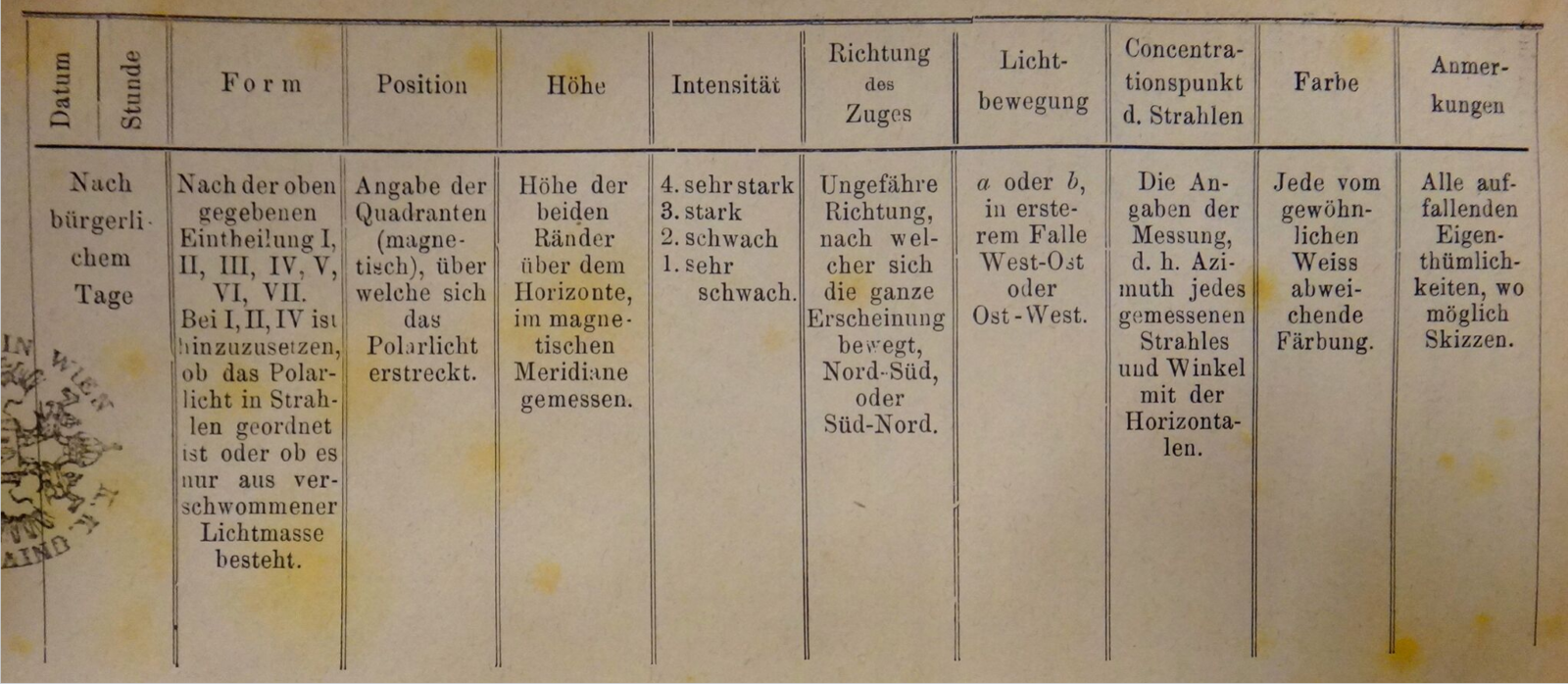This image was drawn by the officer Julius Payer, who was the Commander at Shore of the Austro-Hungarian North Pole Expedition (1872-1874). The expedition was one of several 19th-century scientific expeditions to the Nordic regions and the Arctic that focused on the Northern Lights as a central object of study.
Payer’s image is one example of attempts to depict this northern phenomenon. Scientists and travellers from countries outside the Nordic region faced a major challenge: How could one ‘capture’ a moving phenomenon such as the Northern Lights, how to describe something that most readers knew nothing about, and how to take it home for further research? Admittedly, the Northern Lights could sometimes be seen in southern parts of Europe, but they were very rare.
Knowledge about the Northern Lights increased steadily throughout the 19th century, especially after the connection between the number of sunspots, i.e. the sun’s activity, and the Northern Lights was discovered in the middle of the century. The Northern Lights occur when particles from the sun hit the magnetic field around the Earth. The 19th century was a time of great zeal for geographical and scientific discoveries, and it was believed that the Northern Lights would provide knowledge about the unknown universe. The North became a kind of bridge to outer space.
There were attempts to recreate the Northern Lights in laboratories, and the first successful photographs were taken in the early 1890s. However, it would be a long time before the images could be used for analytical purposes, and before the wandering and ever-changing phenomenon could be captured on film.
Payer later became an artist and specialised in polar themes, and his illustration is more an artistic representation of the Northern Lights than an attempt at a scientific observation. Carl Weyprecht, who was the Commander at Sea during the Austro-Hungarian North Pole Expedition, had a more scientific approach, and together with several other participants on the expedition, he wrote down observations of the Northern Lights in tables, with accurate information about time, place, shape, colour, etc. Both Payer and Weyprecht also used words to describe the Northern Lights: Payer used metaphors and artistic expressions, Weyprecht primarily used scientific and analytical language.

When the expedition returned to the Habsburg Monarchy, the illustrators in Vienna’s newspapers let the Northern Lights shine like a halo over the expedition leaders. Payer's illustration shows how difficult it was to convey a northern phenomenon like the Northern Lights to an audience that could not experience it for themselves. The Northern Lights were a symbol of the mythical and unknown in the North, while also being an object of scientific study. Payer’s picture is titled ‘Eispressungen während eines Nordlichts im Jänner 1873’ (Hummocked ice under the Northern Lights in January 1873). The Northern Lights’ associations with flames are in contrast to the ice that dominates the foreground of the picture. The Nordic region is portrayed as a place of contradictions: between the unknown and the known, the mythical and the scientific.
About the object
Type of object: Illustration
Material: Paper
Technique: Steel engraving (printed in book)
Size: Width 11 cm x length 17.5 cm
Author: Julius Payer (1841-1915)
Podcast
Podcast by master students, History, Department of Archaeology, Conservation and History (in Norwegian)
The Northern Lights and Austria-Hungary
The northern lights are a phenomenon many associate with the Nordic region and with Norway in particular. The light phenomenon attracts tourists from all over the world to the north of Norway and is often considered to be “typically Norwegian”. The northern lights have simply become part of Norway's national identity. In the 19th century, too, the northern lights lured people to the Nordic countries and Norway, and surprisingly, the northern lights became part of Austria-Hungary's nation-building. When Austria-Hungary sent out a polar expedition to the northern regions in 1874, the northern lights came to play a central role for both the expedition and the country's identity.
Made by Lisa Methlie Stefanovic, Oda Christine Rødfoss, Tormod Hindahl, Hans-Markus Jensvold Kverneng, Jostein Hauge. 2022.
Continue reading
Payer, Julius. Die österreichisch-ungarische Nordpol-Expedition in den Jahren 1872–1874, nebst einer Skizze der zweiten deutschen Nordpol-Expedition 1869–1870 und der Polar-Expedition von 1871. Wien: Alfred Hölder 1876.
Payer, Julius. Den østerrigsk-ungarske Nordpol-Expedition i Aarene 1872-1874: tilligemed en Skitse af den anden tydske Nordpol-Expedition 1869-70 og af Polar-Expeditionen i 1871. Translated by F. O. Guldberg. Kristiania: Den norske Forlagsforening (H. Aschehoug & Co. Alb. Cammermeyer. J. W. Cappelen. P. T. Mallings Boghandel.), 1877.
Schimanski, Johan. & Spring, Ulrike. Passagiere des Eises. Polarhelden und arktische Diskurse 1874. Köln, Wien: Böhlau, 2015.
Spring, Ulrike. “Materialising the Aurora: Carl Weyprecht and Scientific Documentation of the Arctic”. In Expeditions as Experiments: Practising Observation and Documentation, edited by Marianne Klemun og Ulrike Spring, 141-162. London: Palgrave Macmillan, 2016.
Spring, Ulrike. “Between Spectacle and Science: The Aurora in Central Europe, 1870s-1880s”. In Acta Borealia 29, nr. 2 (2012): 197-215.
Weyprecht, Carl. Die magnetischen Beobachtungen der österreichisch-ungarischen arctischen Expedition 1872–1874. Wien: Kaiserlich-königliche Hof- und Staatsdruckerei, 1878.
Weyprecht, Carl. Praktische Anleitung zur Beobachtung der Polarlichter und der magnetischen Erscheinungen in hohen Breiten. Wien: Moritz Perles, 1881.
Do you have questions or comments to the text? Contact Ulrike Spring.
